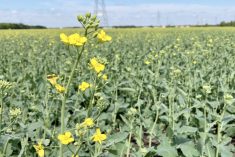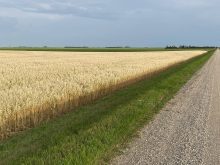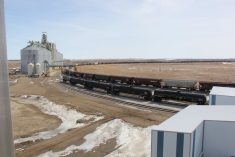A two-year research project underway in southwestern Ontario is evaluating various cover crops, including when and where to plant and how to manage them to achieve the best results. They’re being planted either after winter wheat harvest or into standing corn.
“About five to 10 per cent of field crop growers use them on a regular basis, but there’s a lot of interest in the benefit they can provide,” says project lead Adam Hayes, soil management specialist with the Ontario Ministry of Agriculture and Food (OMAF) at Ridgetown.
Read Also

Dryness poised to threaten Saskatchewan crops
Crops in Saskatchewan are developing in opposite directions, the province’s latest crop report said. Growing conditions in the province vary, with some areas receiving enough rain while other locations are experiencing crop stress due to hot, dry conditions.
“A cover crop can improve the soil, take up or provide nitrogen, help suppress weeds or reduce a nematode population. What you want it to do influences the crop you choose.”
How is the research being conducted?
Post-winter wheat harvest: Two cover crop mixtures — TillageMax Dover (tillage radish and seed oats) and TillageMax Daytona (tillage radish and crimson clover) — plus feed oats were seeded at seven sites in southwestern Ontario.
Into standing grain: Four cover crops — common annual rye grass, Tillage RootMax annual rye grass, feed oats and TillageMax Daytona blend (tillage radish and crimson clover) — were hand seeded into standing grain corn at four sites from the last week of August to the middle of September. One plot was seeded after silage harvest.
What has the project found to date?
Cover crops were harvested in the third and fourth weeks of October last year, and again in November. Those planted post-wheat harvest produced significant growth, with the Dover mixture averaging 3,900 kilograms per hectare and the Daytona plus oats averaging 3,600 kg/hectare. The cover crops planted into standing corn grew sparsely with annual rye grass showing the best growth and establishment. Cover crops planted after corn silage had reasonable growth.
“Seeding depth is one of the challenges with mixes. Planting at the correct depth is important to ensure the cover crop germinates rapidly or even germinates at all,” says Hayes. “In a few instances, cover crop seed was planted one inch or deeper, and although the oats emerged without difficulty, the tillage radish was delayed and often had a reduced stand.”
Chatham-area beef farmer Mike Buis is a participant in the project and although he hasn’t had much success with cover crops in standing corn, he says there are a lot of options after winter wheat. On fields where he can’t graze his cattle, he prefers to use red clover, letting it grow to the top of the wheat stubble before cutting and baling it, and then spraying the regrowth just before freezing.
“Red clover is one that works well year after year. Even after burning the clover off, it gives you good root mass and will hold the soil in place for the winter without a heavy mat lying on top,” he explains.
In grazing fields, Buis avoids clover due to the risk of bloat in his cattle and uses an oats and rye combination instead. The seed is spread on the wheat stubble and disced in with a bit of manure, providing cattle feed for fall or winter and early spring.
“If you use two to three crops in your mix, at least one will always do the job and survive,” he says, adding that he will be including radish in his mix this year to address some soil compaction issues. “If you mix radish with oats and rye and then put cattle out to graze, the radish will break up compaction areas and the rye oats will give you fine roots and cover on top to keep the soil in place.”
Buis has also been involved in the development of a cover crop selector tool with information specific to Ontario conditions, which can be accessed online.
Where can I get more information?
The project is being repeated again in 2013, but more information about results to date can be found online in the Crop Advances section of the OSCIA website.
How was the research funded?
Funding for this project was provided by the Ontario Soil and Crop Improvement Association (OSCIA) regional partner grant in cooperation with the Ontario Ministry of Agriculture and Food and the Southwest Agricultural Conference grant. OSCIA assisted with communication of research results.
— Lilian Schaer is a freelance writer and communications project specialist at Guelph, writing on behalf of the Ontario Soil and Crop Improvement Association (OSCIA).
Adam’s cover crop tips
- Prepare your cover crop plan and order seed early.
- Decide what you want the cover crop to do and what crop diseases are present in your fields before you choose what to plant.
- Consider how you will manage the crop after it’s done – whether frost will kill it off or whether some tillage or herbicide will be needed.
- Make sure you plant your seeds at proper depths. If smaller seeds in your mixture are planted too deep, they won’t come up or may result in a thinner stand or delayed emergence.



















